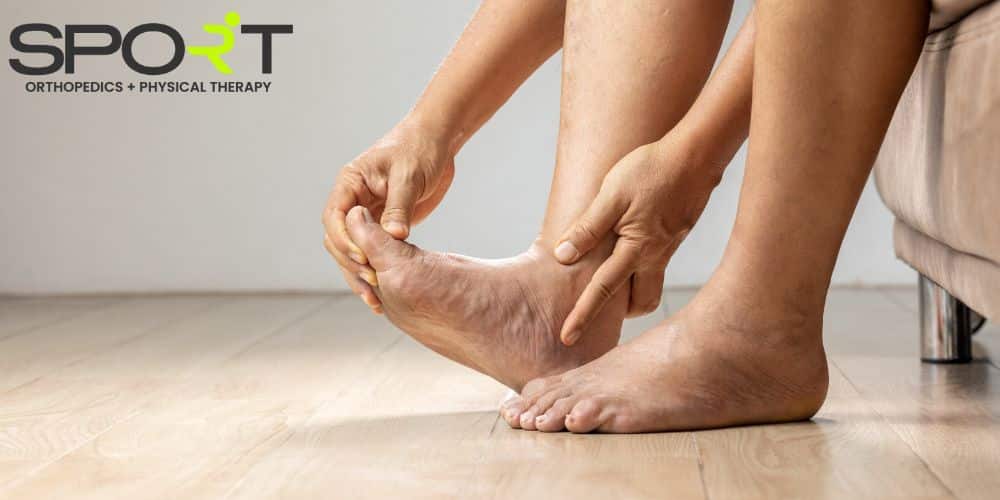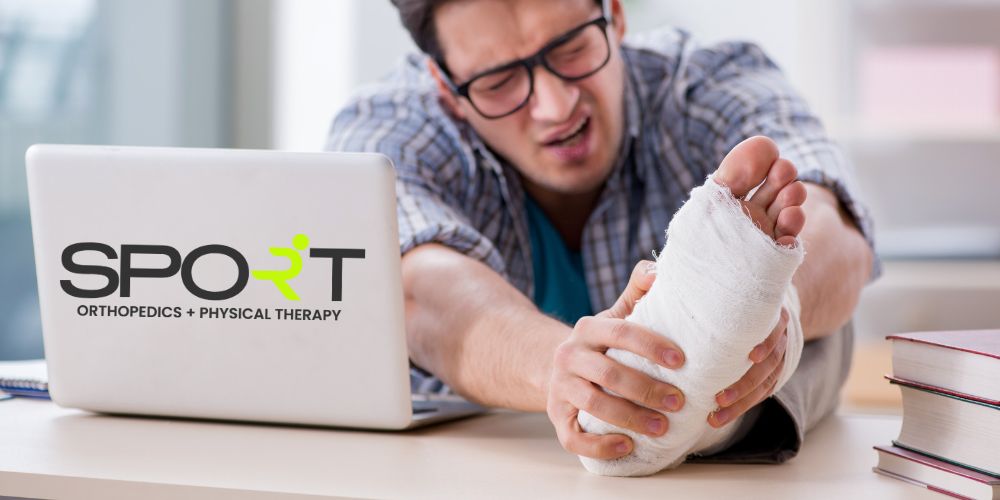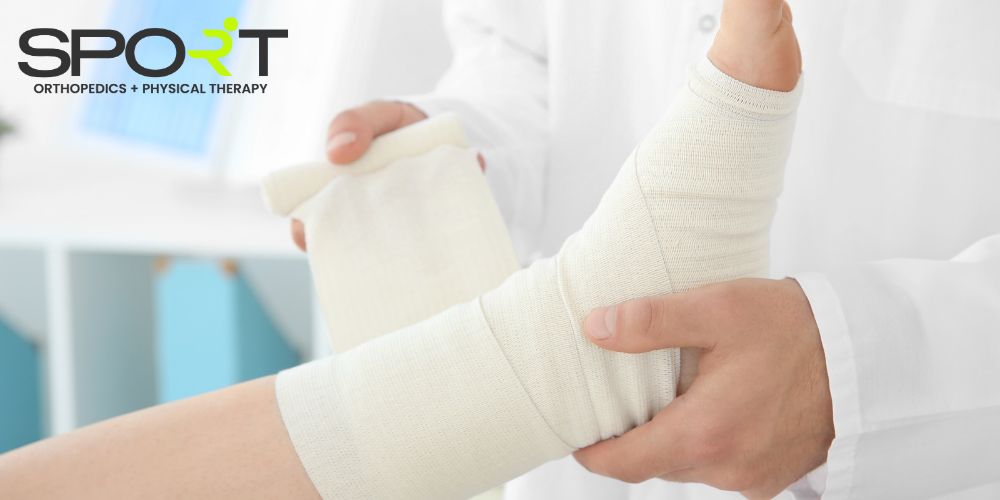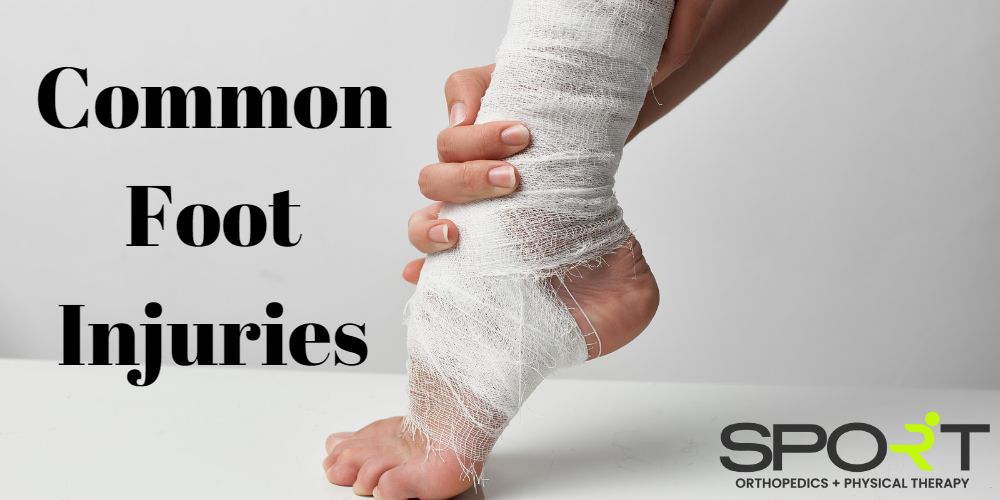Feet provide a solid base for all of our daily activities. Feet are incredibly important–they hold 25% of the bones in the human body. Each foot has 26 bones, 30 joints, and more than 100 muscles, ligaments, and tendons. These parts all work together to give us a solid foundation. When something injures our foundation, it can be a painful experience, both mentally and physically. A foot injury often means we lose mobility, which often means a loss of freedom for many people. The highly skilled providers at SPORT Orthopedics + Physical Therapy can help you get back on your feet after foot injuries, literally! Schedule an appointment online or call one of our three locations to get the help you need. We even have same-day and Saturday appointments available for our patients with hectic schedules. Call us today at (469) 200-2832.
How Do Foot Injuries Happen?
Foot and ankle injuries usually happen in one of two ways: a sudden injury after a fall or contact with a solid object, or an injury from overusing the joint or tissue. Sudden injuries, often referred to as “acute injuries” happen without warning. Muscle strains, fractures, bruises, and puncture wounds are all forms of acute injuries. For example, many people experienced foot pain while running after suffering a mild injury.
Overuse injuries happen when the joints and tissue undergo too much stress. Stress fractures, repetitive motion injuries, and inflammation can all cause immense pain. These injuries are sometimes linked to a specific accident, but sometimes they can happen after overdoing a normal activity.
Some people are more prone to common foot injuries and conditions than others. Some conditions, like bunions, can be hereditary. In other cases, structural issues with the foot like Pes Cavus can contribute to injuries. No matter what kind of injury you have, you can trust the team at SPORT Orthopedics and Physical Therapy to help you through this painful time.
Acute Foot and Ankle Injuries

Acute foot and ankle injuries can put you on the sidelines for a while. Foot and ankle health is an essential aspect of staying mobile. Sprains may sound like an injury that you can power through, but it’s important to get proper treatment to prevent recurrent sprains and more serious injuries in the future.
Sprained Toes
Sprains can occur when ligaments (the connective tissue between joints) are torn or stretched. Eight toes have three joints where sprains can happen. The big toe only has two joints. Sprained toes can happen after trauma or hyperextension of the toe. We’ve all had moments where we’ve stubbed our toes against furniture in the dark. This can result in a painful injury. A sprained toe is sometimes called turf toe when the big toe is sprained. This is because many football players began to get more sprained toes after playing on artificial turf instead of grass. Grade 1 sprained toes can be treated at home with a mix of ice, rest, elevation, and anti-inflammatory medication. Grade 2 and 3 sprains may require a walking boot.
Ankle Sprains
Like toe sprains, an ankle sprain happens after sudden trauma. Low ankle sprains are the most common types of ankle sprains, but high ankle sprains can happen when the leg is forcefully twisted while the foot stays stable. Depending on the circumstances of the ankle injury, recovery time can be anywhere from a few weeks to six months. An unstable high ankle sprain usually requires surgery to keep the joint and ligament in the proper place while healing. A minor sprained ankle can be treated with the normal RICE treatment: rest, ice, compression, and elevation. Over-the-counter anti-inflammatory medication can help control pain and reduce swelling.
Overuse Injuries
Sudden trauma isn’t always the cause of a foot or ankle injury. For many people, additional stress on the bones, tendons, and ligaments can cause severe pain and lead to injuries. For other people, hereditary and structural issues like flat feet can mean a higher risk of foot and ankle conditions. Taking the time to properly stretch can increase your chance of avoiding overuse injuries. Read on below to learn about common overuse conditions and injuries.
Bunions
Many people often have no issues with their bunion–until they do. Bunions often signal a change in the bone structure of your foot. Pressure on your big toe from tight or narrow shoes causes the toe to lean. It’s generally easier to prevent bunions than it is to treat them. Wearing shoes that fit properly and give your toes plenty of room can go a long way in preventing this condition. Some people are more prone to bunions if one or both parents had them.
Bunions can also develop faster on people whose feet are structured differently. These issues can cause some pain and with a large enough bump, they can prevent you from finding shoes that fit correctly. Bunions will not go away without surgical treatment, but this doesn’t mean that surgery is always the best option. Some specialized orthotic devices can slow the progression and allow you to live a life free of discomfort. The skilled orthopedic surgeons at SPORT Orthopedics + Physical Therapy can help determine the best treatment plan for you.
Hammertoes
Hammertoes may start off as funny-looking toes. Claw toes, or hammertoes are caused by a tendon imbalance in your lesser toes. Over time, this tendon imbalance issue can cause pain while walking and even standing. Like bunions, hammertoes can’t be reversed by non-surgical treatment options. People with flexible hammer toes can ease their discomfort with orthopedic devices, but the hammertoe will most likely progress to a rigid hammertoe. A rigid hammertoe requires surgery to help the toe lay flat once more. Hammertoes can cause calluses and corns where the toe rubs against the inside of your shoe.
Anterior Ankle Impingement
Anterior ankle impingement is most commonly known as athlete’s ankle or footballer’s ankle. This chronic ankle pain can flare up during activities that cause extreme movement in the ankle, like squatting, lunging, or kicking. The impingement can also be caused by bone spurs, general inflammation, or scar tissue on the front of the ankle bone. Recurrent ankle sprains can also lead to this condition. In most cases, effective treatment for this condition involves rest, ice, compression, and elevation. Working with a physical therapist at SPORT Orthopedics + Physical Therapy can reduce your recovery time and prevent this condition from flaring up as much in the future.
Stress Fracture
Pushing your body past its limits can result in a stress fracture in the toes, feet, or ankles. Athletes who do a lot of running or jumping can cause tiny cracks in the bones of their feet. Your feet are made up of 26 small bones and take the brunt of impact and weight-bearing. Stress fractures often need plenty of rest to heal, and you should avoid weight-bearing activities by using crutches for a while.
Achilles Tendonitis
Achilles tendonitis (also spelled tendinitis) occurs when the Achilles tendon is inflamed. The Achilles tendon stretches from your heel bone to the calf muscle, making it the biggest tendon in your body. Achilles tendinitis is more common in men and older people. Your tendons experience wear and tear, just like other parts of the body. Unlike an Achilles rupture, Achilles tendonitis isn’t linked to a specific injury. It usually happens from overusing the tendon or pushing yourself too far. Achilles tendonitis can happen to either the middle or lower part of the tendon.
Noninsertional Achilles tendinitis happens in the middle of the tendon. This is more likely to affect young athletes. Insertional Achilles tendonitis affects the lower area of the tendon. Damaged tendon fibers can calcify over time, making the chance of developing heel spurs increasingly likely. Minor cases of Achilles tendonitis can usually heal with the help of a combination of rest and physical therapy. In severe cases or after conservative treatment fails, your provider at SPORT may recommend Achilles tendon surgery.
Plantar Fasciitis
Plantar fasciitis is the inflammation of the plantar fascia. The plantar fascia is the ligament that connects the heel and the ball of the foot. The plantar fascia also supports the arch of your foot. People with a high arch often have a short plantar fascia, and are more likely to develop plantar fasciitis. Plantar fasciitis can be caused by walking or standing on hard surfaces for extended periods of time. The treatment for plantar fasciitis usually involves custom orthotics, stretches, and cold compresses. Many people with plantar fasciitis often develop heel spurs if the plantar fascia pulls away from the bone. This is why it’s important to get treatment as soon as possible.
Heel Spur
Heel spurs are bony growths that form on the heel bone. Calcium deposits can form on the bottom of the calcaneus (heel) bone and cause pain, especially after extended periods of rest. Heel spurs are common in people who do a lot of running, jumping, or jogging. Stretching and straining the plantar fascia, which is the ligament that supports the arch of your foot. Treatment for heel spurs often includes over-the-counter anti-inflammatory medication, cold compresses, and daily stretches. In severe cases, surgery is used to remove the spur or release the plantar fascia to relieve pain.
How Ankle and Foot Injuries Can Impact Your Life

Common foot and ankle injuries can have a negative impact on all aspects of your life. Foot and ankle injuries can cause severe pain, time away from work, and even have a detrimental effect on your mental health. Being put on the sidelines isn’t fun for anybody. At SPORT Orthopedics + Physical Therapy, our providers can help you get your life back.
Get Treatment For Your Feet at SPORT

At SPORT Orthopedics + Physical Therapy, we know how important it is to get back to your normal life. We can help you recover from your injury and get back to living the life you love. From shoulder to toe, we’ve got you covered. We can design a custom treatment plan that helps you heal and reduce your foot pain. For more information, call us today at (469) 200-2832. We can help you schedule a consultation appointment with a trusted Dallas orthopedic professional today.



